5 types of internet addiction

Internet addiction types refer to the different ways people become overly dependent on online activities. Each type involves specific behaviors and triggers affecting how a person interacts with technology.
The 5 types of internet addiction are cybersex addiction, compulsive information seeking (information overload), net compulsions, internet gaming disorder (gaming addiction), and cyber (online relationship addiction).
Cybersex addiction involves an unhealthy fixation on online sexual content or activities. Compulsive information seeking, sometimes called information overload, leads people to endlessly scroll or search for facts, often resulting in poor focus and difficulty retaining useful knowledge.
Net compulsions refer to excessive online habits causing financial problems or stress like shopping or gambling, while internet gaming disorder describes an intense focus on video games. Finally, cyber relationship addiction happens when people prioritize online connections over in-person ones.
1. Cybersex addiction
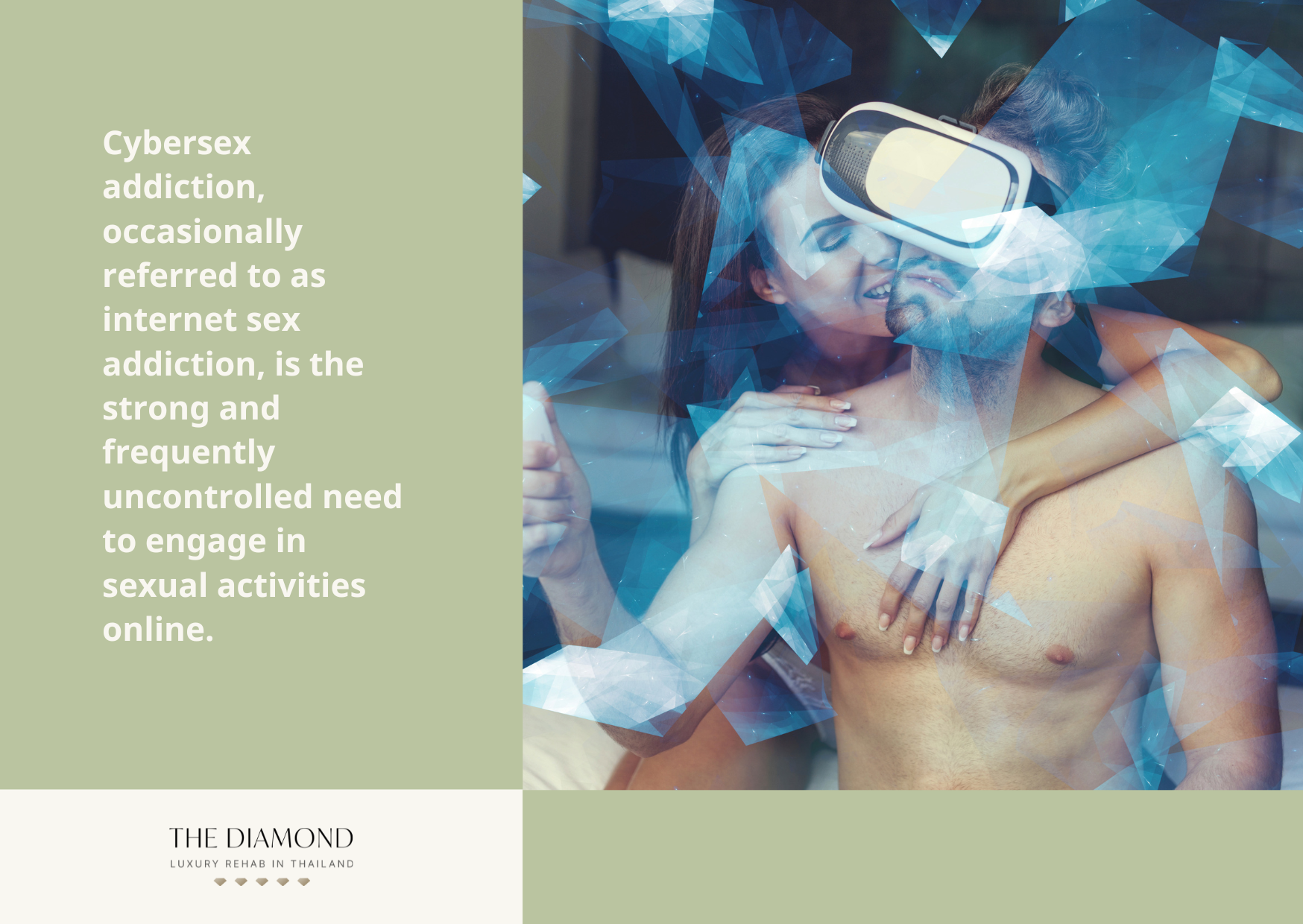
Cybersex addiction, occasionally referred to as internet sex addiction, is the strong and frequently uncontrolled need to engage in sexual activities online. This non-substance addiction is centered on activities like using interactive webcam services, watching porn and taking part in adult chat rooms.
What makes it a specific type of internet addiction is the way digital platforms become the main outlet for sexual expression. The pattern of behavior involved in the condition eventually interferes with one’s social life or emotional well-being, as online sexual content becomes a constant mental preoccupation.
A 2022 paper by Meng et al., titled “Global prevalence of digital addiction in general population: A systematic review and meta-analysis” estimated a global prevalence of 8.23% for cybersex addiction.
The causes of cybersex addiction are easy access to explicit content, emotional pain or trauma, and underlying mental health issues. A 2015 study by Weinstein et al., titled “Factors predicting cybersex use and difficulties in forming intimate relationships among male and female users of cybersex” additionally determined factors influencing cybersex use, including craving for pornography and difficulties in forming intimate relationships.
Widespread availability of adult content online allows people to engage in sexual behavior privately and instantly, encouraging habit-forming use. Past trauma or deep emotional wounds additionally drive individuals to turn to cybersex as a coping mechanism. Underlying mental health conditions such as depression or anxiety increase a person’s tendency to rely on cybersex for short-term emotional relief.
The aforementioned study revealed the need for pornography was the most significant predictor of cybersex usage. Individuals exhibiting heightened desires for pornography were more likely to participate in regular cybersex activities.
Intimacy additionally proved more difficult for people who used cybersex more frequently, citing emotional obstacles such as fear of abandonment, fear of being completely known, and discomfort with emotional intimacy.
The negative effects of cybersex addiction include guilt, emotional detachment, irritability, unrealistic expectations, secrecy and damaged relationships. Numerous people experience shame or regret after engaging in cybersex, particularly during attempts to stop.
The behavior leads to a sense of disconnection from partners as well. Irritability or anxiety tend to surface the moment a person is unable to access online sexual content. One’s view of sex and intimacy eventually becomes distorted, making real-life relationships feel unsatisfying.
Lying or being defensive to cover up the habit inevitably erodes trust in intimate relationships. The most extreme cases result in damaged lives and jobs as the behavior becomes uncontrollable.
2. Compulsive information seeking (information overload)
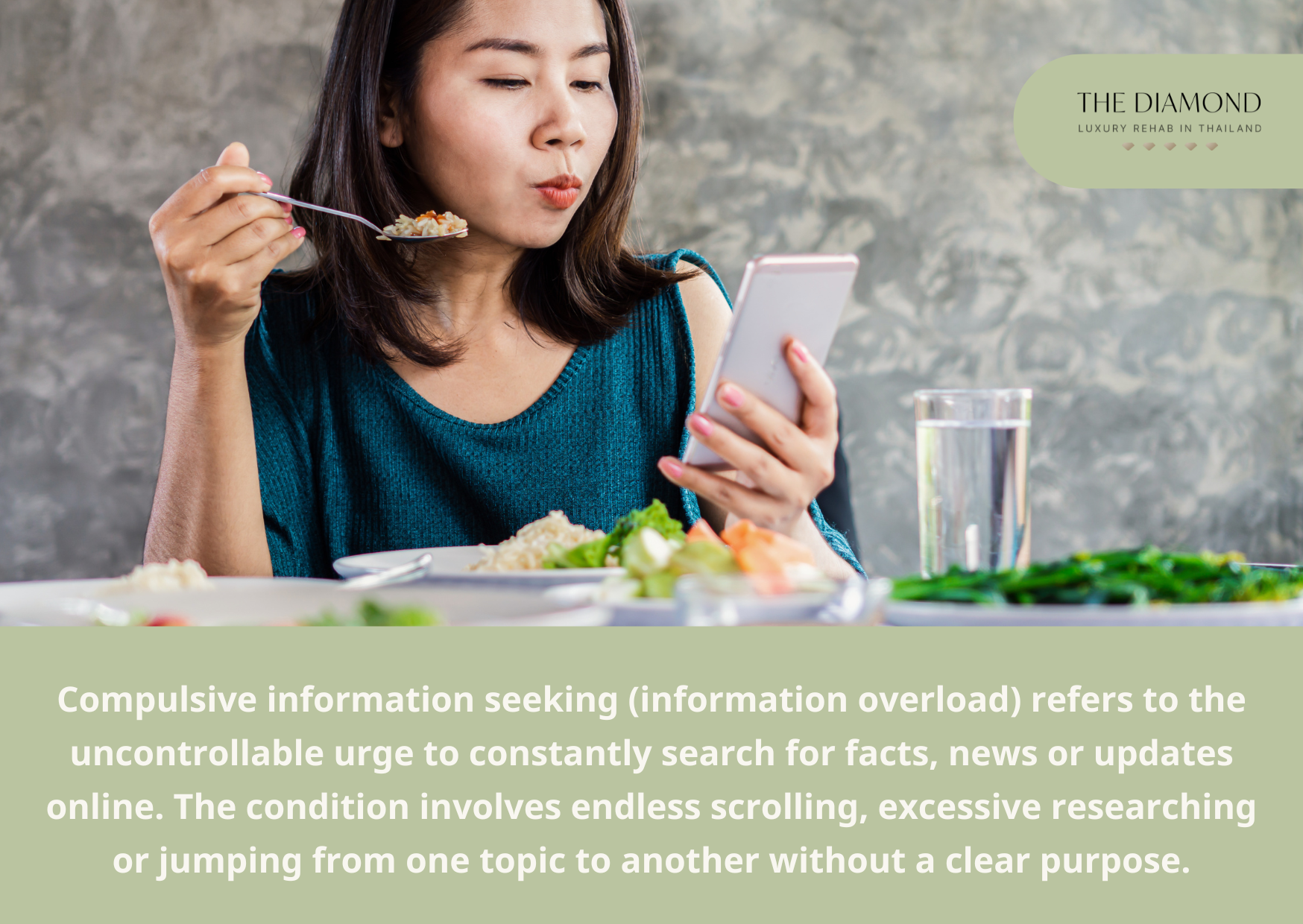
Compulsive information seeking (information overload) refers to the uncontrollable urge to constantly search for facts, news or updates online. The condition involves endless scrolling, excessive researching or jumping from one topic to another without a clear purpose.
People frequently feel drawn to consume more information, even though constant intake causes mental exhaustion or disrupts daily tasks. Most of the time, trying to learn something new feels beneficial. However, in this instance, the activity deviates from healthier online practices by becoming a form of avoidance or diversion.
Research on the global prevalence of excessive information seeking is limited. A 2023 paper by Arnold et al., titled “Dealing with information overload: a comprehensive review” cited Meyer et al. (2021), stating 22.5% of participants in a representative German sample recognized information overload as a prevalent stressor within the German workforce.
The causes of compulsive information seeking include fear of missing out, anxiety, perfectionism, low confidence and emotional avoidance. Fear of missing out pushes people to stay constantly updated, believing every detail must be known the moment it happens.
Anxiety fuels the urge to search for answers because uncertainty feels unbearable. Perfectionism leads to nonstop research in an effort to feel fully prepared or confident, although such a level of detail adds no real value.
The negative effects of compulsive information seeking are mental fatigue, reduced focus, decreased productivity, disrupted sleep, and emotional overwhelm. Mentally, the brain becomes overloaded, leading to difficulty processing or remembering what’s been read.
One’s ability to focus is undermined as attention gets pulled in too many directions. Productivity takes a hit as well, mainly because researching replaces action supposed to be done to accomplish tasks.
Sleep patterns suffer as a result of scrolling or reading late into the night. Over time, the person feels drained and emotionally scattered, with little space left for reflection or rest.
3. Net compulsions
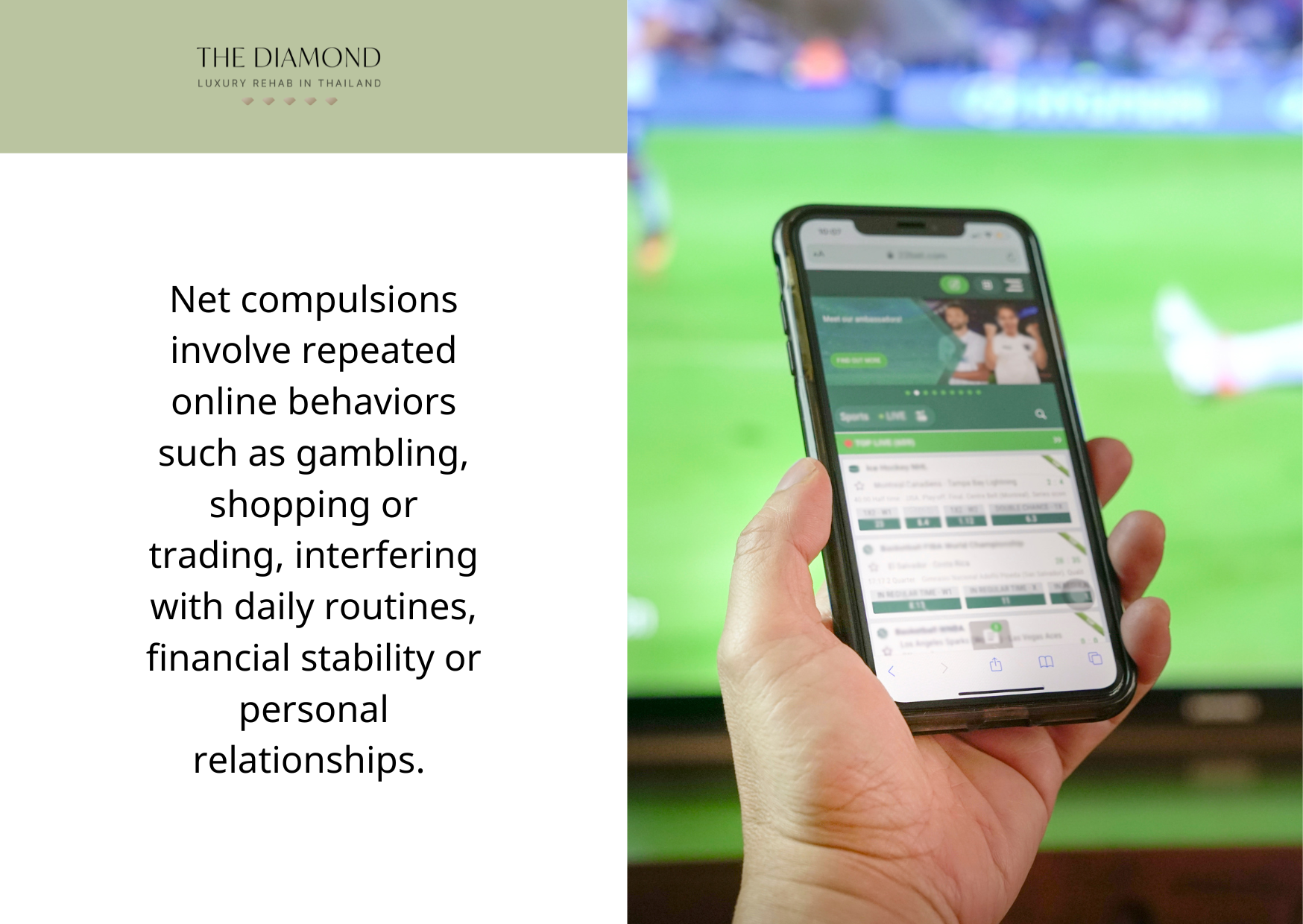
Net compulsions involve repeated online behaviors such as gambling, shopping or trading, interfering with daily routines, financial stability or personal relationships. Casual engagements into such activities slowly escalate into something harder to manage since large amounts of time and money are involved.
Net compulsions stand out as a form of internet addiction due to the way digital platforms make high-risk or high-reward activities constantly available. With constant stimulation, instant results and around-the-clock access, the habits tend to grow more intense than similar offline behaviors, leading to emotional and financial strain.
Net compulsions share the same behavioral patterns as internet addiction, such as online gambling, day-trading and online shopping. Due to the overlap, prevalence rates are generally similar.
A 2022 paper by Meng et al., titled “Global prevalence of digital addiction in general population: A systematic review and meta-analysis” estimated the global rate of internet addiction at 14.22%, which likely reflects the occurrence of net compulsive behaviors as well.
The causes of net compulsions include easy access to online platforms, reward-seeking behavior, boredom, poor impulse control and peer influence. Online gambling, shopping and trading platforms are available 24/7, creating constant temptation and making avoidance difficult.
The thrill of winning, scoring a deal or making quick gains reinforces repeated use. Affected people turn to such activities to pass time or escape boredom. Emotional stress, such as sadness or frustration, drive people to seek relief through impulsive online behavior.
Difficulty managing urges leads one to make choices without thinking through the consequences. Peer conversations additionally tend to normalize excessive spending or gambling.
The negative effects of net compulsions include anxiety, loss of control, financial problems, social withdrawal and emotional burnout. Constant urges to spend or gamble online create mental tension and worry.
A growing sense of loss of control results in difficulty unengaging with the habit, even with apparent consequences. Financial strain becomes a common outcome, not just due to overspending but from neglecting financial responsibilities as well.
4. Internet gaming disorder (gaming addiction)
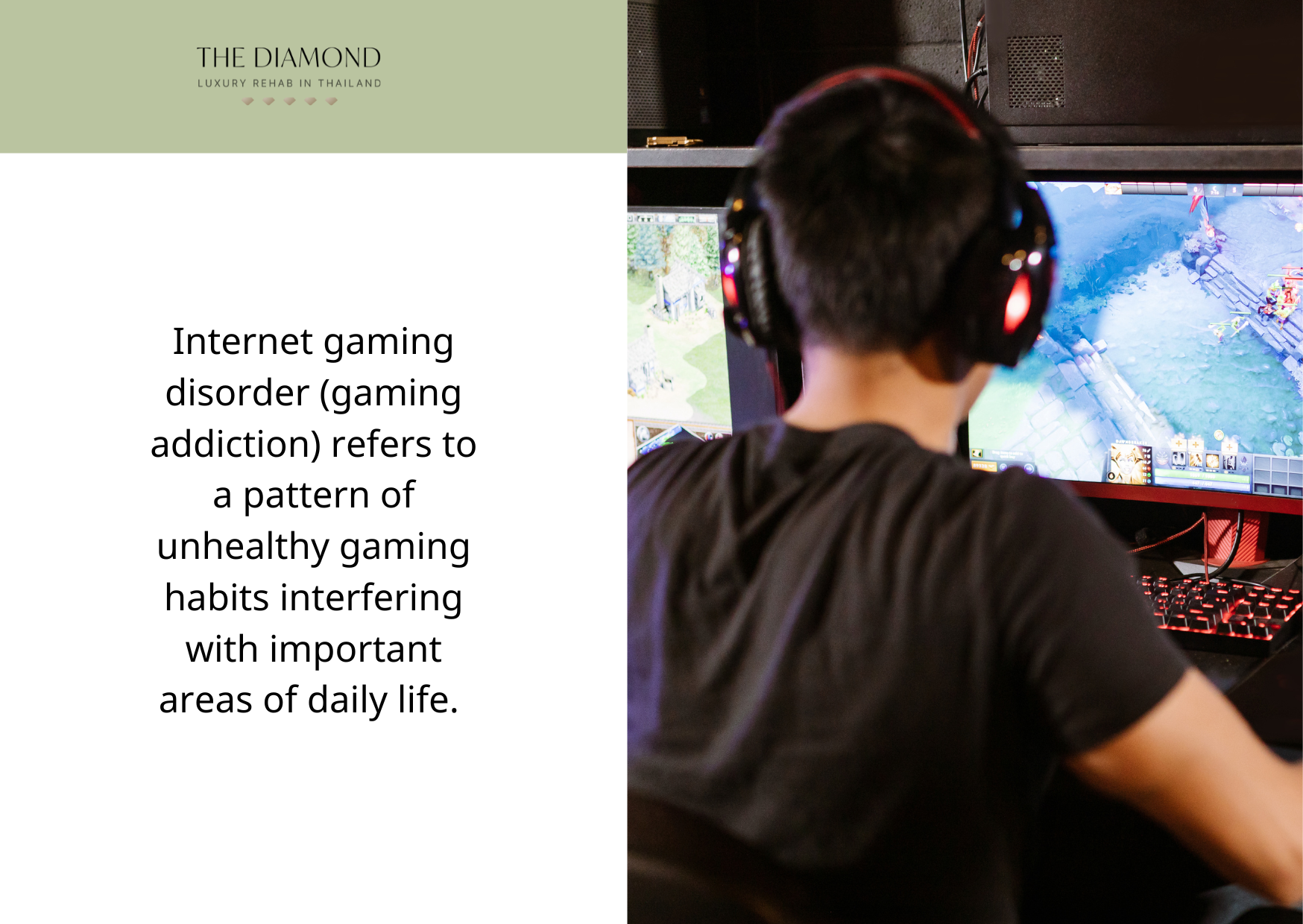
Internet gaming disorder (gaming addiction) refers to a pattern of unhealthy gaming habits interfering with important areas of daily life. People with the condition feel compelled to play a game for long periods, sometimes losing track of time or skipping meals.
Addiction to gaming develops once the desire to play overrides other needs or activities, leading to poor functioning. A strong psychological attachment to virtual achievements, characters or in-game rewards reinforcing the cycle of excessive play sets gaming addiction apart from general internet use.
A 2020 paper by Stevens et al., titled “Global prevalence of gaming disorder: A systematic review and meta-analysis” revealed a global incidence of gaming disorder at 1.96% across all studies examined.
The causes of online gaming addiction include dopamine desensitization, escapism, social isolation, reward-based game design and unmet psychological needs. Dopamine desensitization develops after prolonged exposure to highly stimulating gameplay.
Escapism drives a person to lose oneself in virtual environments as a way to avoid emotional pain or real-life stress. People feeling disconnected from others typically turn to gaming as a replacement for real-life interaction, drawn to the safe environment where acceptance comes more easily.
Online games rely on reward loops like levelling up, unlocking achievements or gaining status, encouraging repeated engagement. Game mechanics promote instant gratification, a contrast to most real-life experiences. This further increases the urge to keep playing.
Finally, emotional needs like validation, purpose or control—once left unmet in everyday life—often drive players to seek a sense of accomplishment through gaming.
The negative effects of gaming addiction span emotional instability, low motivation, disrupted sleep, academic or job decline and poor time management. Excessive gaming leads to emotional highs and lows, where frustration or anger builds during losses or interruptions.
Motivation for daily tasks tends to decline, considering how gaming offers immediate gratification actual responsibilities in life don’t provide. Gaming addicts lose track of time during long gaming sessions, leading to sleep deprivation and exhaustion.
Job performance or schoolwork suffers due to missed deadlines, further fueling stress. Without a clear balance, routines fall apart, and long-term goals take a backseat to the constant draw of the next game.
5. Cyber (online) relationship addiction
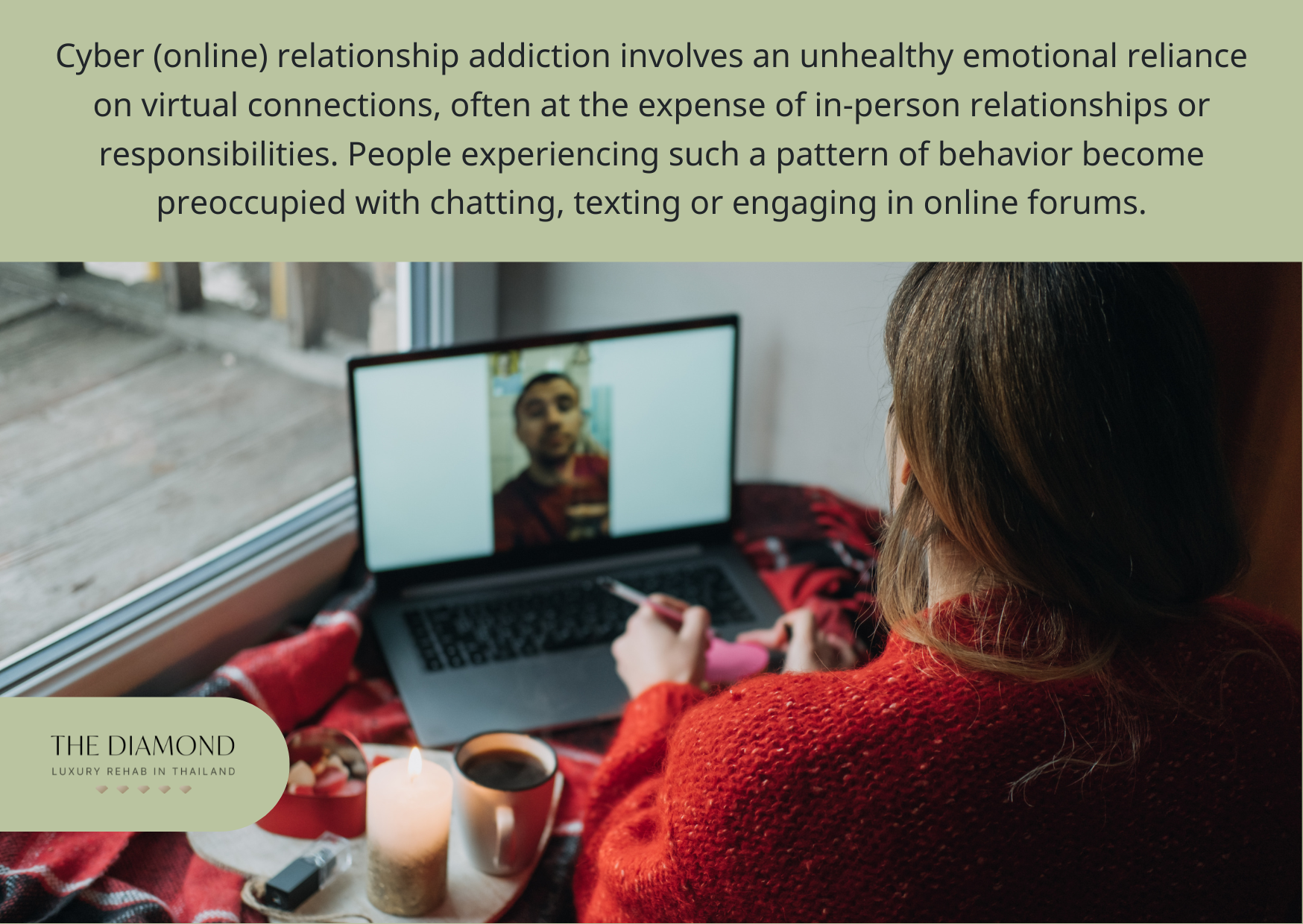
Cyber (online) relationship addiction involves an unhealthy emotional reliance on virtual connections, often at the expense of in-person relationships or responsibilities. People experiencing such a pattern of behavior become preoccupied with chatting, texting or engaging in online forums.
The emotional investment in virtual bonds feels intense, despite no face-to-face interaction between the people involved. The constant need for connection eventually begins to mirror social media addiction, where likes and messages offer a sense of validation.
A person caught in a cyber-relationship cycle starts to depend on digital companionship to feel appreciated. Offline interactions lacking the intimacy found in digital connections lead to disinterest in real-life relationships.
What separates cyber (online) relationships as a form of internet addiction from typical use is the excessive emotional dependence on virtual relationships, where online contact becomes the primary source of connection.
According to a 2014 study by Cecilia Cheng and Angel Yee-lam Li, titled “Internet Addiction Prevalence and Quality of (Real) Life: A Meta-Analysis of 31 Nations Across Seven World Regions,” 6.0% of people worldwide suffer from internet addiction.
In addition to gaming, cybersex, and obsessive online behaviors, the article identified cyber relationship addiction as a subtype of internet addiction. It did not, however, provide a precise prevalence estimate for addiction to online relationships alone.
The causes of cyber (online) relationship addiction include loneliness, unmet emotional needs, poor self-image and the illusion of control. Individuals who feel disconnected from others gravitate toward online spaces, where conversations feel easier and emotional distance provides a layer of safety.
In the absence of emotional support, virtual relationships gradually become the main source of comfort. A poor self-image is likely to push someone to seek affirmation online, with carefully curated profiles helping mask perceived flaws.
The digital nature of such connections gives a sense of control over how much of oneself is shared, allowing people to manage vulnerability in ways real-life relationships do not permit.
The effects of cyber (online) relationship addiction include emotional exhaustion, neglect of in-person relationships, distraction from responsibilities and increased insecurity. Emotional fatigue builds up from maintaining constant digital communication, especially if reassurance or attention becomes necessary to feel emotionally stable.
Offline relationships tend to suffer once online interactions begin taking priority, leading to weakened family ties, fading friendships or conflict in romantic partnerships. Preoccupation with online connections interferes with concentration and daily responsibilities, pulling attention away from important tasks.
As reliance on virtual affirmation increases, feelings of inadequacy deepen, particularly if self-worth begins to depend on the approval of online contacts.
